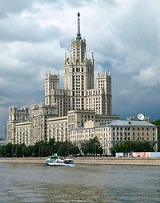
Kotelnicheskaya Embankment
Overview
Moskva River
The Moskva River is a river that flows through the Moscow and Smolensk Oblasts in Russia, and is a tributary of the Oka River.-Etymology:...
in central Tagansky District of Moscow
Moscow
Moscow is the capital, the most populous city, and the most populous federal subject of Russia. The city is a major political, economic, cultural, scientific, religious, financial, educational, and transportation centre of Russia and the continent...
, Russia
Russia
Russia or , officially known as both Russia and the Russian Federation , is a country in northern Eurasia. It is a federal semi-presidential republic, comprising 83 federal subjects...
. It spans from the mouth of Yauza River
Yauza River
This article is about a river in Moscow, a tributary of the Moskva River. There are three other Yauza rivers in Central Russia: tributaries of the Lama, Gzhat and Sestra....
(west) to the point one block west from Bolshoy Krashokholmsky Bridge
Bolshoy Krashokholmsky Bridge
Bolshoy Krasnokholmsky Bridge is a steel arch bridge that spans Moskva River in downtown Moscow, Russia, carrying Garden Ring between Tagansky District and Zamoskvorechye Districts. It was completed in 1938 by V.M.Vakhurkin , G.P.Golts and D.M.Sobolev...
(east), where it changes name to Goncharnaya Embankment.
Kotelnicheskaya Embankment Building is one of seven
Seven Sisters (Moscow)
The "Seven Sisters" is the English name given to a group of Moscow skyscrapers designed in the Stalinist style. Muscovites call them Vysotki or Stalinskie Vysotki , " high-rises"...
stalinist
Stalinist architecture
Stalinist architecture , also referred to as Stalinist Gothic, or Socialist Classicism, is a term given to architecture of the Soviet Union between 1933, when Boris Iofan's draft for Palace of the Soviets was officially approved, and 1955, when Nikita Khrushchev condemned "excesses" of the past...
skyscrapers laid down in September, 1947 and completed in 1952, designed by Dmitry Chechylin (then Chief Architect of Moscow) and Andrei Rostkovsky.

